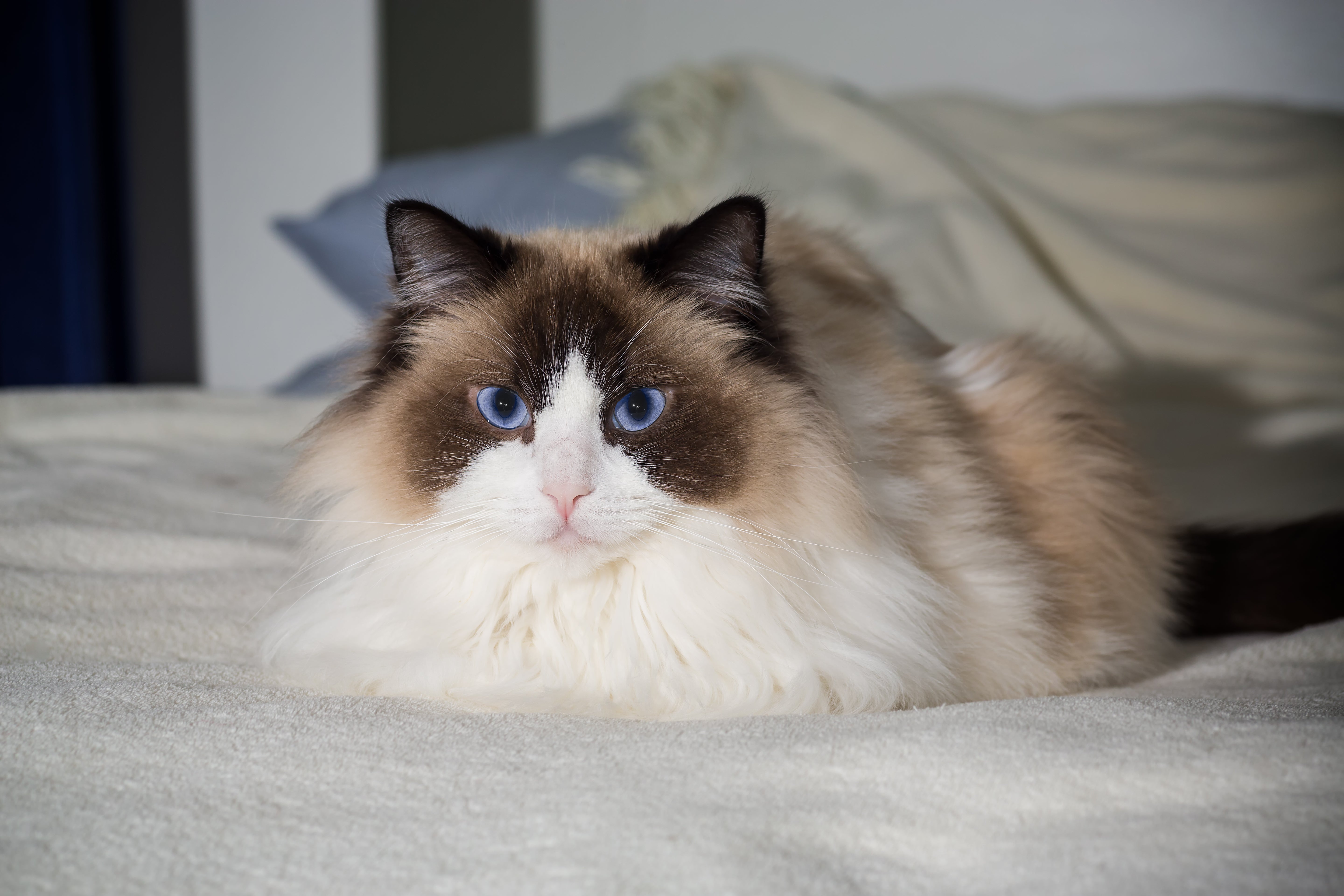Ragdoll
Don’t let their intense blue-steel stares fool you—these cats are love, wrapped up in luxuriant fur. Ragdoll Cats are born with an all-white coat and do not develop their signature darker markings until they are a few weeks old, with their full coats coming in around four years of age. Underneath all that dense, pillowy hair is a long, muscular cat with a broad chest, sturdy legs, and a short neck. Their tails are long, bushy, and perfect for petting.
Breed characteristics carousel
Learn More
Need to Know
- Great for first-time cat owners
- Enjoys playing games and is active at home
- Playful and curious
- Sociable and slightly talkative
- Larger, stockier cat
- Requires regular grooming
- Likes to be indoors and outdoors
- Great family cat
- Ideal for a relaxed home

Personality
Ragdolls are docile, sweet, friendly, and renowned for being laid-back cats. They’re always happy to assume the role of your best friend: they want to spend time with you and assist you in your day-to-day activities and routines (though they prefer to watch instead of participate). Working from home that day? They’ll be right there with you curled up on your desk asking for love.
Ragdolls give what they receive. They are very in touch with their owner’s emotions and sense when you’ve had a hard day and will be the first to curl up in your lap to try to make it all better. They are infamous for being food-motivated but have soft, polite voices (even at dinnertime). Ragdolls are curious cats who are always along for the ride, preferring quality owner time over everything else.
Instead of hard facts about this cat’s origins, endless colorful stories are making it difficult to tell what is true and false. One of the only things we know for certain is that Ragdoll Cats were developed in the 1960s in California.
Ragdolls make great pets, even for inexperienced cat owners. Their easy-going personality and low-key demeanor make them a great fit for most households. They are slow-maturing cats, not fully grown until about 4 years old. For owners seeking an independent cat, a young Ragdoll might not be a good fit.
Ragdolls are large, stocky cats naturally inclined towards laziness if not encouraged by their owners to play and move—making daily exercise important to keep them healthy and fit. When properly motivated, they enjoy climbing on cat trees and chasing and hunting games.
A Ragdoll might become downright prissy when confronted with the outdoors—they don’t love being wet or big swings in temperatures. Owners will likely have to be involved in their exercise. Free access to the outdoors is not recommended as these cats are too laid-back and vulnerable. They are also extremely attractive cats, making them a theft risk.
Ragdolls have a lot of hair in their coat which can mat easily, so like a human, a daily brushing is always a good idea. It can take a while depending on the season and stage of life, so it’s best to try to make it enjoyable for your Ragdoll. Doing a little bit at a time, taking breaks to love on them, and finding ways to make it fun goes a long way.
Ragdolls are sharp animals and generally adapt to training fairly easily. They respond best to positive reinforcement, praise, and treats.
Ragdolls enjoy a home surrounded by people, so ideally they will not be left alone for long periods by themselves. Often, another Ragdoll Cat is a good idea so they can entertain and keep each other company. They require a little more affection and attention than the average cat, so the more people at home who can understand and provide that, the better.
The cost of a Ragdoll cat from a breeder is significantly more than the cost of adopting one from a local shelter or rescue. The adoption fee usually covers additional items such as spaying or neutering, vaccines, and microchipping.
Adopting a Ragdoll Cat
Interested in adopting a Ragdoll cat? Here are answers to some common questions about bringing one of these charming cats home.
Yes, the Ragdoll cat personality is easy-going and loving. They are good for less experienced owners.
The Ragdoll cat size is large and requires more grooming than an average-sized cat. They become very attached to their owners and appreciate spending a lot of time with them.

Learn more about feeding and caring for your Ragdoll on Purina.
Did You Know?
- Ragdoll cats have lovely blue eyes.
- The Ragdoll cat personality will give the impression that they’re nothing but a very cuddly dog. In fact, you might even notice them waiting patiently for their owners to come back home or carrying around their favorite toys. They adore playing fetch, too
- Ragdolls are born pure white. It’s not until after a week or two that they develop different colors and patterns.
- Ragdolls are slow-maturing cats, meaning that they are fully grown at age four. Some of them might even take more time.


